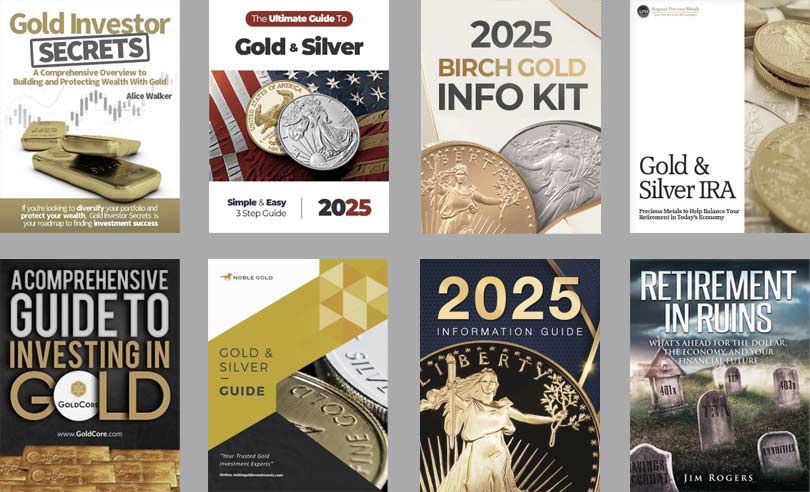
A good part of the past month involved us cautioning investors against panic selling, which headlines appeared to be encouraging.
 Bullion.Directory precious metals analysis 08 July, 2024
Bullion.Directory precious metals analysis 08 July, 2024
By Peter Reagan
Financial Market Strategist at Birch Gold Group
As late as Thursday, we had analyses like this one, wondering whether it was time to sell since gold was supposedly struggling with $2,365.
Surprise: it wasn’t.
In the next few days, gold went right back to the kind of action we’ve gotten used to so far this year, though $2,400 is clearly the next hurdle to overcome.
Reason #1: More Analysts Predicting Higher Gold Prices
UBS, which has already issued its fair share of bullish forecasts, rates the metal as their most preferred hedge heading into H2.
MKS Pamp goes a step further, saying that gold is actually underpriced as we move towards H2 and that precious metals in general stand to reap considerable gains in the second half of the year.
In their report, MKS tackles the notion of summer doldrums and say that gold and silver may start taking off from late July and onwards. That’s quite the statement, as the whole of summer is traditionally viewed as gold’s worst quarter. It was last summer that had gold parked around $1,650 with more bearish headlines than one could stand to read.
So the notion that we might start seeing a serious run towards $2,400 this summer, which one could argue is already underway, is exciting. Let us remember that interest rates haven’t budged this entire time, remaining historically elevated, but gold made the leap from $1,650 to $2,400 nonetheless.
Should gold experience delays in its run because the move from $2,300 to $2,400 is happening during what is known as its worst quarter, we fully expect analysts to mostly ignore these points and again wonder if it’s time to part with our bullion. Yet the outlook is bright enough to entertain other possibilities.
A strong economic report like this one would have, in the past, been used to justify any kind of price slump gold may be experiencing. But since it’s going up, it’s actually being quoted as contributive, saying that the economic strength was “expected”.
Ever since gold started this run, we’ve seen an astounding number of fickle narratives, a trend we imagine will continue.
We were told that China pausing reports on gold purchases for a single month caused some kind of immediate correction in gold. Even though China has once again not reported any purchases, it doesn’t seem to have affected gold in any way.
It might simply be that convincing people that China isn’t buying gold off the books is getting increasingly difficult, if not impossible.
And on another positive note, silver passed $31, showing that it has shed some of its recent inability to keep up with gold. While we’ve called $30 the key level and it’s hard to argue the psychological importance, some pundits have actually said that the action begins when silver establishes itself above $28.
Either way, the current price is something to be optimistic about, but let’s be real: for as high as gold can go in this run, with big-name forecasters listing $3,000 and onwards as a viable option, silver has even more room.
If it shrunk the gold/silver ratio a little bit and moved to $50 in short order, with gold mostly remaining static, would anyone be surprised? It feels like it would be a long past due moment, more than anything.
We could say that the real summer doldrums for gold are going to come in the form of inaction on behalf of the Federal Reserve. It’s almost like the Fed is stifling gold more by not doing anything than by moving the nominal rate in either direction.
The markets are waiting for something, and in the absence of that something, tend to price in the worst-case scenario.
The Fed rate cut still has to come, and that is the main thing to look out for. That gold is doing what it’s doing with rates being so elevated shows how strong the fundamentals are, and how uncertain the global outlook is despite the occasional claim to the contrary.
Reason #2: Central Bank Gold Demand Expected to Last Decades
Last week, we took some time to dismiss an interview that downplayed the importance of central bank gold buying. It doesn’t exactly hold water to say that central banks can’t be driving gold prices up when they ramp up purchases tenfold.
Really, we’ve only had two years of head-turning demand in terms of mainstream coverage. More seasoned analysts will know that purchases have been steadily increasing since 2010, but for most, it will be the 1,136 ton figure and last year’s close approach to it.
We could reword it as saying that we’ve only had two years of the kind of central bank gold demand that is pushing and keeping prices above $2,000. What will happen after decades of this? The World Gold Council (WGC) recently entertained this notion, saying in an interview with the somewhat aptly-named Reinvent Money channel that the buying isn’t going anywhere.
WGC’s John Reade delved into what these purchases mean, saying that all emerging market nations might look to have an up to 50% allocation to gold within a decade or two.
He seems split between reasons in the form of sanctions and hyperinflation, which is a little curious. That is to say, it’s curious to begin with to say that central banks are buying gold due to hyperinflation.
Yes, there can be many other factors including sanctions, but when it boils down to it, central banks are causing the hyperinflation. They’re the ones pushing for an inflation rate when nobody else seems to want it. And, as anyone with an eye on the markets can note, any kind of tumult sends inflation spiraling upwards, not downwards.
So this goes back to our earlier notion that central banks have essentially absconded with currency, be it their own or that of other sovereign nations. With the gold purchases, they’re practically saying that fiat isn’t a good thing to store wealth in.
To hear central banks are buying gold to protect themselves against inflation is a strange statement, but we live in strange times.
Reade is fully aware that most of the buying comes from emerging markets, and that these markets tie to BRICS one way or another. Which emerging market these days is considered a Western ally more so than a BRICS nations one?
Reade touches upon many other things of note, including the gold repatriations that we’ve been seeing from various nations. He believes London can no longer be the neutral, gold-price fixing hub that it once was, where nations are more than happy to store their bullion. Sanctions are again the reason, and here, it’s hardly exaggerated: since the start of the Russian invasion of Ukraine, it seems one can’t turn in either direction without the LBMA reminding us of good and bad bullion.
He brings up an interesting point regarding a possible BRICS currency, saying that we actually have a precedent for it. Reade notes that the euro is the result of 20-something countries pooling together for a shared currency with limited results.
One might be eager to say that there is no comparison here, since European Nation countries have proven themselves more responsible with money than emerging market ones. But have they?
The euro itself has brought inflation to each country it was introduced in, and today, remains another free-floating, depreciating currency that just lost its global reserves share spot to gold.
So the point can just as easily be made that a BRICS currency could be more successful than the euro because it’s backed by gold, and therefore automatically negates some of the downsides pertaining to EMs’ money management.
He finds the idea quite feasible, saying that a BRICS currency’s gold backing could give it the kind of immediate clout that its members want.
It seems to be a slow-moving process, though, unlike the bullion purchases which are barreling year after year. Given gold’s performance over the past year, one of the main things to look out for in the gold market will be the effect of consecutive annual official sector purchases exceeding 1,000 tons.
Gold might be disconnected from the physical market, but only to an extent. The vaults can only be depleted of so many thousands of tons of bullion before the price can no longer take it.
Reason #3: Younger Investors Now More Likely to Buy Gold
BofA study finds millennials and Gen Z three times as likely to buy gold. Here’s why:
How surprised are we to hear that newer generations are three times as likely to buy gold than older ones? A lot of it is stereotype. Boomers save, zoomers spend.
But a recent study done by BofA suggests that things aren’t nearly as straightforward.
Both millennials and Gen Z-ers find themselves in an environment that can easily be argued as worse than Paul Volcker’s tightening 50 years ago.
While it was unpleasant for everyone, there was a kind of clear vision to that tightening schedule. If it worked out, inflation would be brought to check, and the rate could be pulled back.
Since the start of the current tightening, though, analysts have been pointing out that the conditions aren’t nearly as favorable. The rate is just as high, but the effect is uniformly expected to be limited. The ongoing hints that the Federal Reserve might want to settle for a 4% inflation rate are the start of the problem.
The Fed is already being pushed to reverse course, but unlike when Volcker’s administration did it, there are broad expectations that inflation is going to spring back up right away with a big “Now what?” sticker on it.
So perhaps it isn’t so much that older generations are unaware of gold’s benefits, but rather that the younger generations are becoming hyper-aware, by force. Gold investment was seen as optional by so many in the 80s, the 90s and even the 2000s.
These days, if you hold any wealth, you can’t afford to keep it in cash because it will disappear.
To that point, for many, traditional investment options like the 60/40 portfolio no longer hold the same allure and security that they once did. Claiming any kind of economic strength is difficult when the IMF is projecting years of consecutive drops in global growth. And it’s becoming quite the effort to convince anyone to be liable for trillions of dollars of debt.
In her commentary on the findings, Katy Knox, president of Bank of America Private Bank, almost had an ominous tone:
“We’re living through a period of great social, economic and technological change alongside the greatest generational transfer of wealth in history.”
Instead of making out newer generations to be more investment-savvy, our takeaway is that older generations should be brought up to speed on the dangers to individual wealth.
We have talks of gold standards on one end, but for the most part, sound money has gone out the window and MMT seems to be the Western answer for the foreseeable future.
Understanding that will quickly bridge the gap that BofA found, and all that’s left is to slowly observe what could very well be the doom of free-floating fiat.
Peter Reagan

Peter Reagan is a financial market strategist at Birch Gold Group, one of America’s leading precious metals dealers, specializing in providing gold IRAs and retirement-focused precious metals portfolios.
Peter’s in-depth analysis and commentary is published across major investment portals, news channels, popular US conservative websites and most frequently on Birch Gold Group’s own website.
This article was originally published here












 Material provided on the Bullion.Directory website is strictly for informational purposes only. The content is developed from sources believed to be providing accurate information. No information on this website is intended as investment, tax or legal advice and must not be relied upon as such. Please consult legal or tax professionals for specific information regarding your individual situation. Precious metals carry risk and investors requiring advice should always consult a properly qualified advisor. Bullion.Directory, it's staff or affiliates do not accept any liability for loss, damages, or loss of profit resulting from readers investment decisions.
Material provided on the Bullion.Directory website is strictly for informational purposes only. The content is developed from sources believed to be providing accurate information. No information on this website is intended as investment, tax or legal advice and must not be relied upon as such. Please consult legal or tax professionals for specific information regarding your individual situation. Precious metals carry risk and investors requiring advice should always consult a properly qualified advisor. Bullion.Directory, it's staff or affiliates do not accept any liability for loss, damages, or loss of profit resulting from readers investment decisions.

Leave a Reply